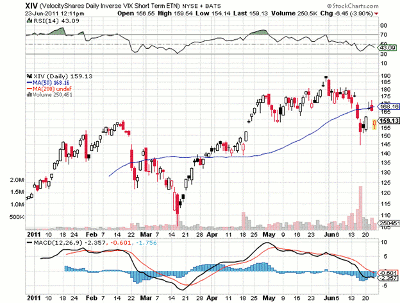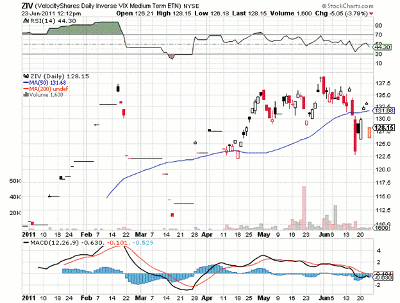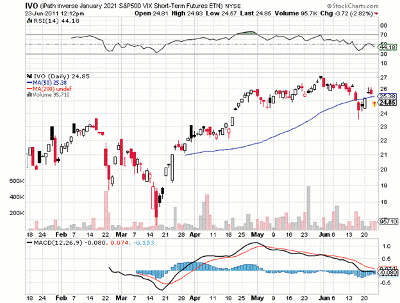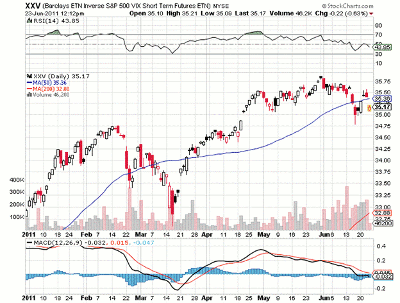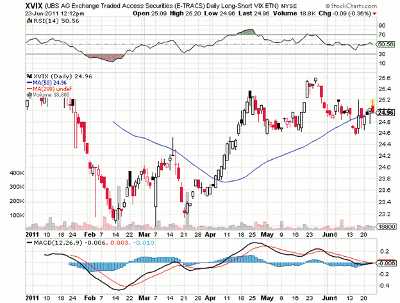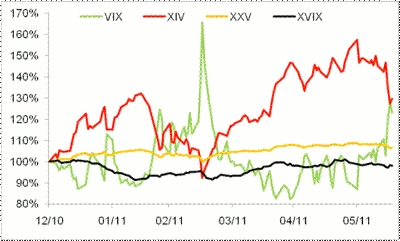New ETF products allow traders and investors to gain exposure to volatility-based indexes like the VIX with the same ease and flexibility of buying a stock.
As the lineup of ETFs approaches the 1,300 mark, a growing pool of issuers continue to deliver innovative new products that tap into strategies and asset classes that have never before been accessible through the exchange traded structure.
One relatively new area that has attracted billions of dollars in new assets in recent years is the volatility space; there are now 15 exchange traded products (ETPs) in the ETFdb volatility category with aggregate assets of nearly $3 billion.
The development of volatility ETPs has been an interesting illustration of the increasingly wide reach of the ETF industry. Unlike stocks and bonds, a direct investment in volatility isn’t possible; the relevant values are derived from prices of other securities, and it isn’t possible to simply go out and “buy” volatility.
Because volatility tends to move in the opposite direction of equity markets, the idea of transforming this metric into an investable asset had obvious appeal to investors looking to bet on a spike in anxiety, or to use as an efficient hedging tool in connection with more advanced short-term strategies.
The development of futures and options linked to volatility contracts made such an investment possible–at least for those with the ability to trade and monitor positions in derivatives.
The packaging of those securities within the exchange traded wrapper wasn’t far behind, and that innovation made establishing exposure to volatility as easy as buying shares of Google (GOOG) or Microsoft (MSFT).
The Appeal of Inverse VIX ETFs
The first VIX ETNs offered long-only exposure to an index comprised of futures contracts, and these products quickly became popular among short-term traders as instruments for hedging equity positions or for speculating on short-term swings in stocks.
It didn’t take long for anyone using the VIX products over a longer time period to get a feel for the impact of the futures-based strategy on bottom line returns.
VIX futures markets are often in a state of “contango,” meaning that long-dated futures are more expensive than those closer to expiration. At the short end of the maturity curve, that contango can be quite steep.
That means that the “roll yield” incurred when selling expiring contracts to buy up next-to-expiration futures can be hefty, creating a significant gap between a futures-based VIX ETP and the hypothetical return on a spot investment in the VIX (which isn’t possible).
Last year, the iPath S&P 500 VIX Short-Term Futures ETN (VXX) lost more than 72% of its value, a massive decline compared to the more modest 18% dip in the spot VIX.
More recently, a number of ETNs have debuted that effectively give investors tools for exploiting the structural inefficiencies in VIX futures markets that accounted for that huge discrepancy. These inverse VIX ETPs essentially allow investors to play the role of the insurance company, selling portfolio insurance with a relatively high premium.
If the big one hits—like it did in 2008—these products are likely to get pummeled by a surge in volatility. But if measures of volatility hold steady or even rise modestly, the wind at the back of these products gives investors a potentially compelling return- enhancement mechanism.
Inverse VIX ETNs
Those looking to establish inverse exposure to the VIX and profit from the same contango that cripples long-only funds over the long run have a number of options to choose from. And while there are some general similarities, many of these inverse VIX ETNs are quite different from one another (sign up for the free ETFdb newsletter here).
NEXT: 5 ETFs That Profit from Option Volatility
|pagebreak|VelocityShares Daily Inverse VIX Short-Term ETN (XIV)
This ETN is perhaps the most efficient tool available for those looking to profit from the steep contango in VIX futures markets. XIV seeks to deliver daily results that correspond to the inverse of an index made up of short-term futures contracts.
That focus means that XIV is often hammered when volatility spikes, but should perform well during periods of falling or even flat volatility. Because XIV seeks to deliver the inverse of a futures-based index, it isn’t uncommon for this product to rack up gains during periods in which the spot VIX actually climbs.
Here’s a daily chart:
It’s important to note that XIV resets exposure on a daily basis; that frequency can have a significant impact on the risk/return profile of this fund. Investors with a holding period of longer or shorter than a day may experience returns that vary from the target -1x multiple, and the compounding of returns can either work for, or against, investors.
Since its launch in November 2010, XIV has gained nearly 70%, making it one of the top ETP performers over that stretch. The spot VIX has declined by about 15% during that same stretch, illustrating the potentially powerful benefits to shorting a strategy facing stiff headwinds in the form of consistent contango.
VelocityShares Daily Inverse VIX Mid-Term ETN (ZIV)
This ETN also offers inverse exposure to an index comprised of VIX futures, but focuses on a benchmark comprised of securities with a longer time until maturity.
The related index has a constant weighted average maturity of five months, which reduces both the volatility and the impact that the slope of the futures curve has on calculated returns. As a result, ZIV will generally experience both single-day and multi-period price swings that exhibit near-perfect correlation to XIV, only with less volatility. For investors looking to tap into the inverse VIX investment thesis with less substantial risk in the event of a stock market collapse, ZIV can be a useful tool.
Here’s a daily chart:
NEXT: Two Funds for Trading Short-Term VIX Futures
|pagebreak|iPath Inverse January 2021 S&P 500 VIX Short-Term Futures ETN (IVO)
This ETN also offers inverse exposure to an index comprised of short-term VIX futures, as IVO and XIV are linked to the same benchmark. However, this iPath ETN strives to achieve this objective over the term of the note (as opposed to over the course of a single trading session).
Launched in early 2011, IVO matures ten years later; that period represents the period over which IVO will deliver inverse exposure.
Here’s a daily chart:
As the underlying index moves, the effective exposure offered varies as well. Just as products like XIV and ZIV will only achieve their target multiple over the course of a single trading day, IVO will only achieve its target objective over the course of the note.
Those getting into this product somewhere along the line are likely to achieve results that vary considerably from the target multiple of -1.0. Currently, the participation value for IVO is 0.62, indicating that a position established now will only experience a fraction of the inverse movement in the underlying index between now and maturity.
iPath Barclays ETN+ Inverse S&P 500 VIX Short-Term Futures ETN (XXV)
XXV debuted in July 2010, and the notes mature in July 2020. Since this ETN launched, the underlying index has plummeted, thanks in no small part to persistent contango in VIX futures markets.
The steep decline has had a couple effects on XXV, and this ETN has performed quite well, gaining close to 75% over the last year. That run-up has also diminished the participation ratio significantly, meaning that investors buying in now won’t experience long-term returns that correspond to -100% of the underlying index.
Here’s a daily chart:
Recently XXV’s participation ratio was just 0.13, indicating that the movement in this ETNs price shouldn’t be expected to come close to the inverse of changes in the related index.
While the performance of the note over the life of the obligation will meet that objective, the steep run-up in value (XXV has gained more than 70% since inception last July) has diminished the sensitivity to further movements in the index.
NEXT: Get Long/Short VIX Exposure with One ETF
|pagebreak|E-TRACS Daily Long-Short VIX ETN (XVIX)
This ETN from UBS is unique in that the underlying index includes both long and short exposure to VIX—specifically a 100% long position in mid-term VIX futures and a 50% short position in short-term VIX futures contracts.
The short position allows XVIX to benefit from the structural inefficiencies in the VIX futures markets, while the long position allows for exposure to volatility that may not be as adversely impacted by contango. XVIX rebalances exposure on a daily basis.
Here’s a daily chart:
The methodology behind XVIX makes this product very unique from the others highlighted above in terms of risk/return profile. The combination of long and short exposure to similar asset classes results in a relatively low volatility—a feature the other inverse VIX ETNs do not share.
XVIX might be useful for those looking to add non-correlated assets to their portfolio, as the movements in the underlying benchmark will generally exhibit very little correlation to stocks or bonds.
Big Differences in Performance
The nuances highlighted above may seem subtle, but they can have a huge impact on performance. Through the end of last week, XIV had gained about 30% year-to-date, more than quadrupling the gains turned in by another inverse VIX ETN (XXV was up about 7%).
Each of these products has the potential to be a very useful tool or a wildly inappropriate mechanism; that all depends on the risk tolerance and objectives of the individual investor.
By Michael Johnston of ETFdb.com

